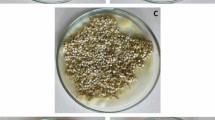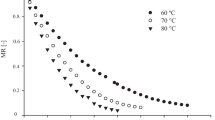Abstract
Effect of four different cultivars and salt pretreatment on drying of Amla (Emblica officinalis) gratings were studied. Quality attributes namely, ascorbic acid, total phenolic content, antioxidant activity and colour were evaluated for dried (using Cabinet tray dryer at 55 ± 2 °C for 8 h) and stored (refrigerated, ambient and accelerated condition) samples of four cultivars (Krishna, Kanchan, NA-7 and Chakaiya). Salt pretreated dried samples showed better retention of nutrients and colour as compared to untreated. Retention of ascorbic acid, total phenolic content and antioxidant activity (IC50 value) in pretreated dried samples were in the range of 79.51–84.89%, 176.5–220.3 mg GAE/g db and 9.48 to 17.74 mg/µl, respectively. Colour retention was also found to be better in salt pretreated samples. Ambient storage condition resulted in higher retention of ascorbic acid and colour compared to accelerated condition. Taking into consideration, the nutritional value of the fresh Amla, ability to retain nutritional value and color during drying and storage, NA-7 cultivar Amla (pretreated with 1% salt, tray dried at 55 °C for 8 h) is the most suitable for preparation of Amla powder. The method developed in the present work is devoid of blanching step and found to be effective in retaining the nutrients during drying and storage and can be employed also for drying of similar fruits and vegetables.




Similar content being viewed by others
References
Agrawal S, Chopra CS (2004) Changes in ascorbic acid and total phenols in making aonla product. Bev Food World 31:32–34
Akbulut A, Durmuş A (2009) Thin layer solar drying and mathematical modeling of mulberry. Int J Energy Res 33:687–695
Alfaro S, Mutis A, Quiroz A, Seguel I, Scheuermann E (2014) Effects of drying techniques on murtilla fruit polyphenols and antioxidant activity. J Food Res 3:73–82
AOAC (2005) Official methods of analysis, 18th edn. Association of Official Analytical Chemists, Gaithersburg
Bomben JL (1977) Effluent generation, energy use and cost of blanching. In: Proceedings eighth national symposium on food processing wastes: March 30–April 1, 1977, Seattle, Washington. US Environmental Protection Agency, Office of Research and Development, Industrial Environmental Research Laboratory, p 85
Brand-Williams W, Cuvelier ME, Berset CLWT (1995) Use of a free radical method to evaluate antioxidant activity. LWT-Food Sci Technol 28:25–30
Chandralekha A, Tavanandi AH, Amrutha N, Hebbar HU, Raghavarao KSMS, Gadre R (2016) Encapsulation of yeast (Saccharomyces cereviciae) by spray drying for extension of shelf life. Drying Technol 34(11):1307–1318
Chandralekha A, Rani A, Tavanandi HA, Amrutha N, Hebbar U, Raghavarao KSMS (2017) Role of carrier material in encapsulation of yeast (Saccharomyces cerevisiae) by spray drying. Drying Technol 35(8):1029–1042
Deka BC, Sethi V, Prasad R, Batra PK (2001) Application of mixtures methodology for beverages from mixed fruit juice/pulp. J Food Sci Technol 38(6):615–618
Doymaz I (2004) Convective air drying characteristics of thin layer carrots. J Food Eng 61:359–364
Duncan DB (1955) Multiple range and multiple f-test. Biometrics 11:1–5
Gornicki K, Kaleta A (2007) Drying curve modelling of blanched carrot cubes under natural convection condition. J Food Eng 82:160–170
Goyal RK, Kingsly ARP, Kumar P, Walia H (2007) Physical and mechanical properties of aonla fruits. J Food Eng 82:595–599
Gudapaty P, Indavarapu S, Korwar GR, Shankar AK, Adake RKV, Bandi V, Kanchu SR (2010) Effect of open air drying, LPG based drier and pretreatments on the quality of Indian gooseberry (aonla). J Food Sci Technol 47:541–548
Kadam DM, Samuel DVK, Parsad R (2006) Optimization of pretreatments of solar dehydrated cauliflower. J Food Eng 77:659–664
Karla CL (1988) The chemistry and technology of Amla (Phyllanthus emblica)—a resume. Indian Food Packer 42(4):67–82
Kingsly RP, Goyal RK, Manikantan MR, Ilyas SM (2007) Effects of pretreatments and drying air temperature on drying behaviour of peach slice. Int J Food Sci Technol 42(1):65–69
Kumar GS, Nayaka H, Dharmesh SM, Salimath PV (2006) Free and bound phenolic antioxidants in Amla (Emblica officinalis) and turmeric (Curcuma longa). J Food Comp Anal 19(5):446–452
Kumari P, Khatkar BS (2016) Assessment of total polyphenols, antioxidants and antimicrobial properties of aonla cultivars. J Food Sci Technol 53(7):3093–3103
Kumari P, Khatkar BS (2018) Nutritional composition and drying kinetics of aonla fruits. J Food Sci Technol 55(8):3135–3143
Lavelli V, Zanoni B, Zaniboni A (2007) Effect of water activity on carotenoid degradation in dehydrated carrots. Food Chem 104(4):1705–1711
Lawless HT, Heymann H (2010) Sensory evaluation of food principles and practices. Chapman & Hall, New York
Liu X, Cui C, Zhao M, Wang J, Luo W, Yang B, Jiang Y (2008) Identification of phenolics in the fruit of emblica (Phyllanthus emblica L.) and their antioxidant activities. Food Chem 109(4):909–915
Mishra P, Dutta N, Mahanta CL (2015) Partial extraction and identification of phenolics in Amla (Emblica officinalis) seed coat powder. J Food Sci Technol 52(11):6990–7001
Mitra SK, Pathak PK, Chakraborty I (2008) Underutilized tropical and subtropical fruits of Asia. Acta Hortic 770:67–76
Okos MR, Narsimhan G, Singh RK, Witnauer AC (1992) Food dehydration. In: Heldman DR, Lund DB (eds) Handbook of food engineering. Marcel Dekker, New York, pp 1–10
Pareek S, Kaushik RA (2012) Effect of drying methods on quality of Indian gooseberry (Emblica officinalis Gaertn.) powder during storage. J Sci Ind Res India 71(11):727–732
Pareek S, Kitinoja L, Kaushik RA, Paliwal R (2009) Postharvest physiology and storage of ber. Stewart Postharvest Rev 5(5):1–10
Pathak PK, Preeti D, Kumar S (2009) Effect of post-harvest treatments on shelf-life of aonla (Emblica officinalis) fruits damaged during harvesting. J Food Sci Technol 46(3):283–285
Prajapati VK, Nema PK, Rathore SS (2011) Effect of pretreatment and drying methods on quality of value-added dried aonla (Emblica officinalis) shreds. J Food Sci Technol 48(1):45–52
Ranganna S (1986) Handbook of analysis and quality control for fruit and vegetable products, 2nd edn. Tata McGraw Publ Co., Ltd., New Delhi
Suhaj M (2006) Spice antioxidants isolation and their antiradical activity: a review. J Food Comp Anal 19:531–537
Tembo L, Chiteka ZA, Kadzere I, Akinnifesi FK, Tagwira F (2008) Blanching and drying period affect moisture loss and vitamin C content in Ziziphus mauritiana Lamk. Afr J Biotechnol 7(17):3100–3106
Tripathi VK, Singh MB, Singh S (1988) Studies on comparative compositional changes in different preserved products of Amla (Emblica officinalis) var. Banarasi. Indian Food Packer 42(4):60–66
Zheng W, Wang SY (2001) Antioxidant activity and phenolic compounds in selected herbs. J Agric Food Chem 49:5165–5170
Acknowledgements
The authors gratefully acknowledge the Director CSIR-CFTRI, for providing the facilities, University Grant Commission (UGC) for fellowship and Ministry of Food Processing Industries for the financial aid.
Author information
Authors and Affiliations
Corresponding author
Ethics declarations
Conflict of interest
The authors declare that they have no conflict of interest related to this work.
Additional information
Publisher's Note
Springer Nature remains neutral with regard to jurisdictional claims in published maps and institutional affiliations.
Electronic supplementary material
Below is the link to the electronic supplementary material.
Rights and permissions
About this article
Cite this article
Sonkar, N., Rajoriya, D., Chetana, R. et al. Effect of cultivars, pretreatment and drying on physicochemical properties of Amla (Emblica officinalis) gratings. J Food Sci Technol 57, 980–992 (2020). https://doi.org/10.1007/s13197-019-04131-8
Revised:
Accepted:
Published:
Issue Date:
DOI: https://doi.org/10.1007/s13197-019-04131-8




